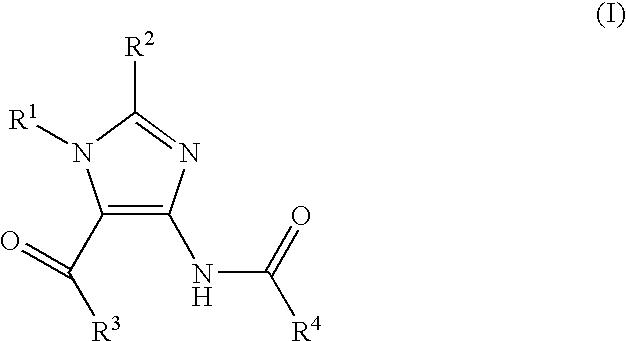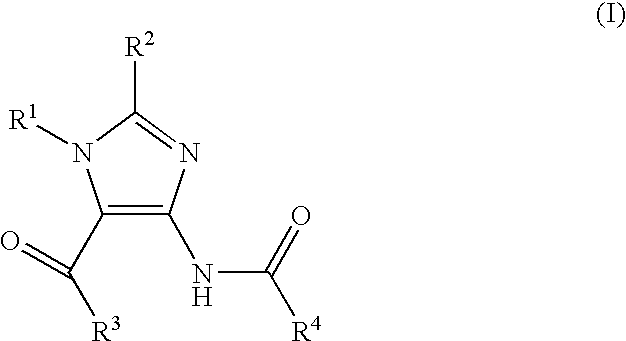Imidazole variants as modulators of GABA receptor for the treatment of GI disorders
a gaba receptor and gaba receptor technology, applied in the direction of biocide, heterocyclic compound active ingredients, drug compositions, etc., can solve the problems of not being useful for the treatment of gerd or functional gastrointestinal disorders
- Summary
- Abstract
- Description
- Claims
- Application Information
AI Technical Summary
Benefits of technology
Problems solved by technology
Method used
Image
Examples
example 1
Synthesis of 1H-imidazole-5-carboxylic acid, 4-[(3,4-dichlorobenzoyl)amino]-2-(methylthio)-1-(phenylmethyl)-, ethyl ester
[0139]
[0140]1H-imidazole-5-carboxylic acid, 4-amino-2-(methylthio)-1-(phenylmethyl)-, ethyl ester (29 mg, 0.1 mmol) was dissolved in THF (700 μl) in a 1 ml vial. 50 mg of polymer supported diisopropylethylamine (3.5 mmol / g) and subsequently 3,4-dichlorobenzoyl chloride (31 mg, 0.15 mmol) was added. The reaction mixture was stirred overnight at room temperature and then filtered over an Isolute-NH2 column (200 mg) washing through with THF (1 ml). The THF was evaporated in vacuo to yield the product (35 mg, 75%).
[0141]NMR 1H 400 MHz (CDC13): 1.15 (3H, t, COOCH2CH3), 2.85 (3H, s, SCH3), 4.3 (2H, q, COOCH2CH3), 5.45 (2H, s, Ar—CH2), 7.1 (2H, Ar—H), 7.2-7.35 (3H, m, Ar—H), 7.55 (1H, Ar—H), 7.75 (1H, Ar—H), 8.05 (1H, Ar—H), 10.0 (1H, s, NH)
example 2
Synthesis of 1H-imidazole-5-carboxylic acid, 4-amino-2-(methylthio)-1-(phenylmethyl)-, ethyl ester (Used as Intermediate)
[0142]
[0143]Carbamimidothioic acid, N′-cyano-N-(phenylmethyl)-, methyl ester (2 g, 9.7 mmol), bromo ethyl acetate (1.79 g, 10.7 mmol) and potassium carbonate (1.48 g, 10.7 mmol) was dissolved / suspended in DMF (20 ml) and stirred for 1 h at 60° C. During the same time 0.56 g of sodium metal was dissolved in 12 ml of ethanol (99.9%). The reaction was cooled and the sodium ethoxide solution was added dropwise over 5 minutes. The reaction was then taken up to 90° C. for 5 minutes, cooled to room temperature and water added until precipitation of the product. The product was filtered and washed with ethanol / water (1:1) to yield 1.9 g (67%) of 1H-imidazole-5-carboxylic acid, 4-amino-2-(methylthio)-1-(phenylmethyl)-, ethyl ester. 0.5 g was recrystallised from ethanol / water to provide >95% pure (410 mg) 1H-imidazole-5-carboxylic acid, 4-amino-2-(methylthio)-1-(phenylmethy...
example 3
Synthesis of carbamimidothioic acid, N′-cyano-N-(phenylmethyl)-, methyl ester (Used as Intermediate)
[0145]
[0146]To dimethylcyanodithioimidocarbonate (8.2 g, 56 mmol) dissolved in ethanol (150 ml, 99.9%) was added benzylamine (10 g, 93 mmol). A thick white precipitate formed after about 10 seconds. The mixture was heated at reflux for 3 hours. The reaction was cooled to room temperature and the precipitate formed was collected by filtration and washed with ethanol (yield 6.43 g). The filtrate was evaporated and ethanol (50 ml) added. The resultant white precipitate was filtered, washed with ethanol to give a second crop (yield 2.66 g). Total yield of carbamimidothioic acid, N′-cyano-N-(phenylmethyl)-, methyl ester was 79%.
[0147]NMR 1H 400 MHz (DMSO): 2.6 (3H, s, SCH3), 4.5 (2H, s, Ar—CH2), 7.2-7.4 (5H, m, Ar—H), 8.9 (2H, br. s, NH2)
[0148]The following compounds were synthesized in an analogous method to Example 1 (RT=retention time, TOF ES+=electrospray MS, i.e. molecular weight+1):
[...
PUM
| Property | Measurement | Unit |
|---|---|---|
| temperature | aaaaa | aaaaa |
| temperature | aaaaa | aaaaa |
| temperature | aaaaa | aaaaa |
Abstract
Description
Claims
Application Information
 Login to View More
Login to View More - R&D
- Intellectual Property
- Life Sciences
- Materials
- Tech Scout
- Unparalleled Data Quality
- Higher Quality Content
- 60% Fewer Hallucinations
Browse by: Latest US Patents, China's latest patents, Technical Efficacy Thesaurus, Application Domain, Technology Topic, Popular Technical Reports.
© 2025 PatSnap. All rights reserved.Legal|Privacy policy|Modern Slavery Act Transparency Statement|Sitemap|About US| Contact US: help@patsnap.com



